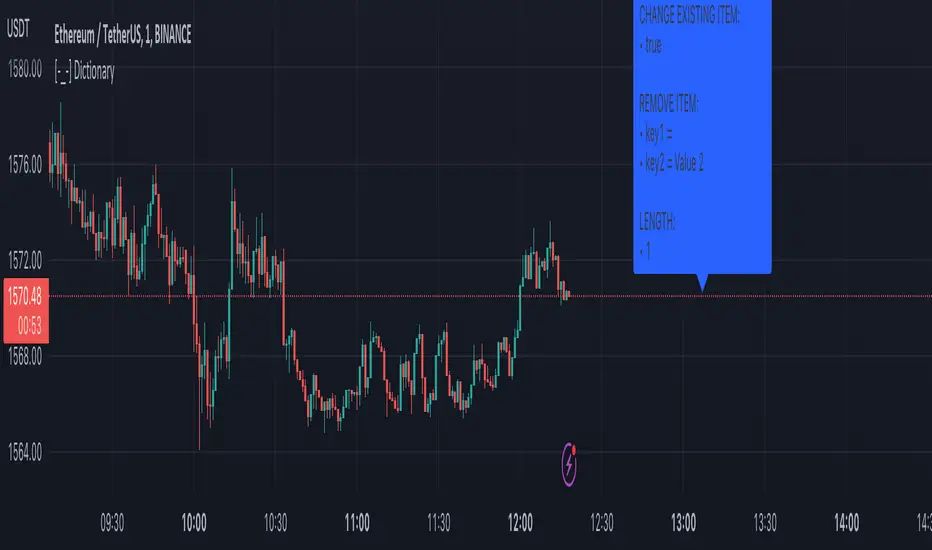OPEN-SOURCE SCRIPT
[-_-] Dictionary

The script shows an example implementation of dictionary-like data type which can store key:value pairs (Python style). Both keys and values can have any of the following type:
• string
• integer
• float
• boolean
• color
You can add items of different types to the same dictionary (e.g. key = 12 and value = "value" stored in the same dictionary with key = "key" and value = 0.23).
Under the hood dictionary is a custom Object (see tradingview.com/pine-script-docs/en/v5/language/Objects.html), that has two array<string> fields (one for storing keys, another for storing values). Keys and values of different types are converted into a string representation when adding a new item to the dictionary. The value is then converted back to certain type (bool/color/etc.) from that string representation when being retrieved. Script also utilises the new Methods (see tradingview.com/pine-script-docs/en/v5/language/Methods.html).
The following methods are implemented:
• init() -> initialises the array<string> fields of dictionary (without this the script throws an error "Array methods can't be called when ID of array is na"
• set(key, value) -> add a new item to dictionary; if an item for given key already exists - change it to new value
• getS(key) -> get value of string type
• getI(key) -> get value of integer type
• getF(key) -> get value of float type
• getB(key) -> get value of boolean type
• getC(key) -> get value of color type
• remove(key) -> removes item from dictionary
• len() -> get length of dictionary (the number of keys)
I could not make just one "get" function that returns any type of value (color/string/etc.), so instead I created a get function for each value type. Example usage:
• you add a string item: dictionary.set(2, "string here")
• you add a float item: dictionary.set(3, 24.56)
• to retrieve first value (key=2) do this: dictionary.getS(2)
• to retrieve second value (key=3) do this: dictionary.getF(3)
• string
• integer
• float
• boolean
• color
You can add items of different types to the same dictionary (e.g. key = 12 and value = "value" stored in the same dictionary with key = "key" and value = 0.23).
Under the hood dictionary is a custom Object (see tradingview.com/pine-script-docs/en/v5/language/Objects.html), that has two array<string> fields (one for storing keys, another for storing values). Keys and values of different types are converted into a string representation when adding a new item to the dictionary. The value is then converted back to certain type (bool/color/etc.) from that string representation when being retrieved. Script also utilises the new Methods (see tradingview.com/pine-script-docs/en/v5/language/Methods.html).
The following methods are implemented:
• init() -> initialises the array<string> fields of dictionary (without this the script throws an error "Array methods can't be called when ID of array is na"
• set(key, value) -> add a new item to dictionary; if an item for given key already exists - change it to new value
• getS(key) -> get value of string type
• getI(key) -> get value of integer type
• getF(key) -> get value of float type
• getB(key) -> get value of boolean type
• getC(key) -> get value of color type
• remove(key) -> removes item from dictionary
• len() -> get length of dictionary (the number of keys)
I could not make just one "get" function that returns any type of value (color/string/etc.), so instead I created a get function for each value type. Example usage:
• you add a string item: dictionary.set(2, "string here")
• you add a float item: dictionary.set(3, 24.56)
• to retrieve first value (key=2) do this: dictionary.getS(2)
• to retrieve second value (key=3) do this: dictionary.getF(3)
Script open-source
Dans l'esprit TradingView, le créateur de ce script l'a rendu open source afin que les traders puissent examiner et vérifier ses fonctionnalités. Bravo à l'auteur! Bien que vous puissiez l'utiliser gratuitement, n'oubliez pas que la republication du code est soumise à nos Règles.
Clause de non-responsabilité
Les informations et publications ne sont pas destinées à être, et ne constituent pas, des conseils ou recommandations financiers, d'investissement, de trading ou autres fournis ou approuvés par TradingView. Pour en savoir plus, consultez les Conditions d'utilisation.
Script open-source
Dans l'esprit TradingView, le créateur de ce script l'a rendu open source afin que les traders puissent examiner et vérifier ses fonctionnalités. Bravo à l'auteur! Bien que vous puissiez l'utiliser gratuitement, n'oubliez pas que la republication du code est soumise à nos Règles.
Clause de non-responsabilité
Les informations et publications ne sont pas destinées à être, et ne constituent pas, des conseils ou recommandations financiers, d'investissement, de trading ou autres fournis ou approuvés par TradingView. Pour en savoir plus, consultez les Conditions d'utilisation.